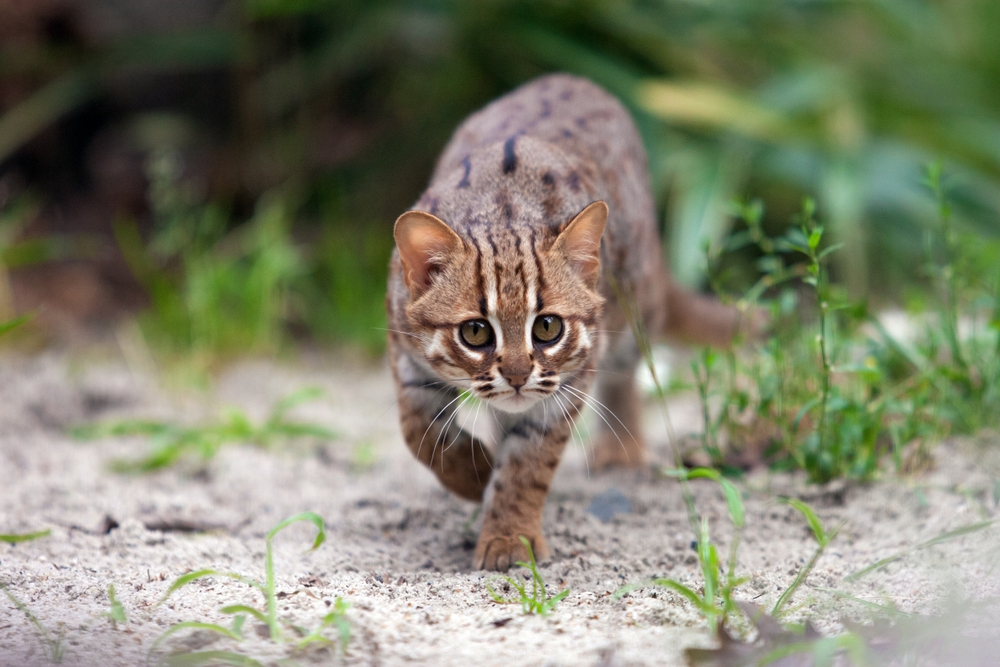7 Fascinating Wild Felines That Just Might Make You a Cat Person
Posted on Categories Discover Magazine

With forty wild feline species scattered across the globe, cats boast an array of adaptations that allow them to thrive in some of Earth’s harshest environments.
Here, we marvel at some of the extremes of the cat world – smallest, fluffiest and more – and see what evolution has done with these magnificent mammals.
1. Cheetah: The Speed Demon
(Credit: Elana Erasmus/Shutterstock)
Holding the records for the world’s fastest cat and fastest land animal, cheetahs (Acinonyx jubatus) can reach speeds of over 60 miles per hour.
Every part of this fast feline is built for speed. Their non-retractable claws act like cleats, providing traction during high-speed chases. Their tails, measuring roughly 2.5 feet, serve as rudders, allowing them to turn on a dime. Even their breathing is adapted for speed; thanks to their relatively small teeth, cheetahs have room for larger nasal passages that allow for quick air intake.
Cheetahs’ endangered status has made them the focus of captive breeding programs at zoos. Occasionally, these captive cheetahs are paired with canine companions to reduce their shyness and make them more willing to mate.
Read More: Who Are the Fastest Animals in the World — and Why?
2. Rusty-Spotted Cat: The Diminutive Hunter
(Credit: Felineus/Shutterstock)
Miniature but mighty, the rusty-spotted cat (Prionailurus rubiginosus) takes the title of world’s smallest cat. When fully grown, this compact carnivore tips the scales at a mere 5 pounds.
A master of hide-and-seek, the rusty-spotted cat is found in the forests of India, Sri Lanka and, as of its 2016 discovery, Nepal. Using their agility and tree climbing prowess, rusty-spotted cats hunt small animals including rodents, birds, lizards, frogs and insects.
Though these petite predators could potentially adapt to living alongside human populations, threats from domestic dogs and vehicles remain a constant danger to their survival.
3. Sand Cat: The Dexterous Desert Dweller
(Credit: Yair Leibovich/Shutterstock)
The sand cat (Felis margarita), native to the Sahara Desert, Arabian Peninsula and parts of central Asia, is equipped to endure extreme conditions.
These desert dwellers boast thick fur and heavily padded paws, insulating them against temperatures that can fluctuate from a scorching 120 degrees to below freezing. During the blistering daytime, these cats take refuge in burrows, only emerging to hunt under the cover of night.
Adding to their list of desert adaptations is their ability to go weeks without drinking water. Instead, sand cats get all the hydration they need from their food. These bold predators are skilled enough to hunt venomous snakes, alongside easier prey like rodents, lizards and insects.
Read More: The Saharan Sand Cat: A Tiny Feline Capable of Great Feats
4. Pallas Cat: The Ultimate Fluff Ball
(Credit: Tonic Ray Sonic/Shutterstock)
When it comes to fluff, no cat beats the Pallas cat (Otocolobus manul). Sporting the longest, densest fur among all cats, this feline wonder is decked out with fur nearly twice as long on their belly and tail than on their top and sides. This luxuriously thick coat isn’t just for show – it keeps them toasty on hunts on snowy or frozen terrain, changing seasonally to become even longer and heavier during winter.
These cats prefer the high life, making their homes in the steppe grassland regions of Mongolia, China and the Tibetan Plateau, where they thrive at elevations up to a dizzying 15,000 feet.
5. Fishing Cat: The Aquatic Adventurer
(Credit: slowmotiongli/Shutterstock)
Defying the stereotype that “cats despise water” that hangs over house cats, the fishing cat (Prionailurus viverrinus) doesn’t hesitate to plunge right in. This water-loving cat makes its home in marshes, swamps and flooded agricultural areas in south and southeast Asia.
Equipped with partially-webbed toes, the fishing cat is an exceptional swimmer. Their fur is specially adapted to act as a kind of dry suit that prevents water from reaching the skin. They also have claws that don’t fully retract, which helps them snag slippery fish to eat.
Besides fish, their diet includes small mammals, birds and shellfish.
Read More: 6 Animals With Unusual Evolutionary Traits
6. Snow Leopard: The Long-Tailed Trekker
(Credit: Abeselom Zerit/Shutterstock)
Inhabiting the stark, frigid peaks of Central Asia, the snow leopard (Panthera uncia) reigns as the cat with the longest tail relative to body size.
When measured from nose to tail tip, the snow leopard’s tail can make up half of their body length. This multipurpose appendage aids snow leopards in maintaining balance on rugged terrain, providing insulation against the severe cold, and storing additional fat for times when prey is scarce.
Powered by formidable hind legs, these elusive cats can leap six times their body length.
But the snow leopard’s vulnerable conservation status make it difficult for scientists to learn more about them in the wild.
7. Siberian Tiger: The King of Cats
(Credit: GUDKOV ANDREY/Shutterstock)
With mature males weighing up to 600 pounds, the Siberian tiger (Panthera tigris altaica) is the largest living member of the wild cat family. These formidable cats, also known as Amur tigers, roam the forests of eastern Russia, as well as parts of China, North Korea and Mongolia.
To fuel their massive, powerful bodies, Siberian tigers hunt deer, wild pigs and whatever other meat they can get their paws on, consuming up to 100 pounds in one sitting.
In addition to their utility in hunting, their large paws function like natural snowshoes, enabling them to effortlessly navigate through deep snow.
Despite their strength, these majestic creatures face a significant challenge: a lack of genetic diversity due to threats from increasing human populations, habitat loss, illegal hunting and expanded trade in tiger parts for traditional medicines.
Read More: Sorry, ‘Tiger King,’ but Big Cats Don’t Make Good Pets